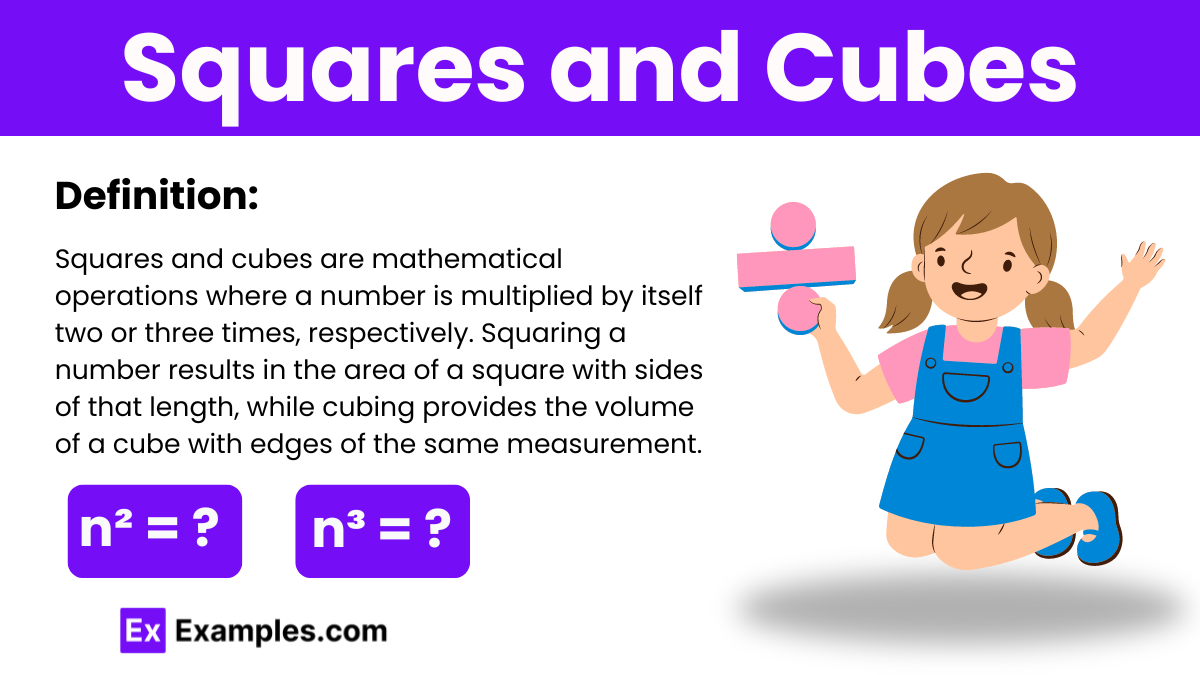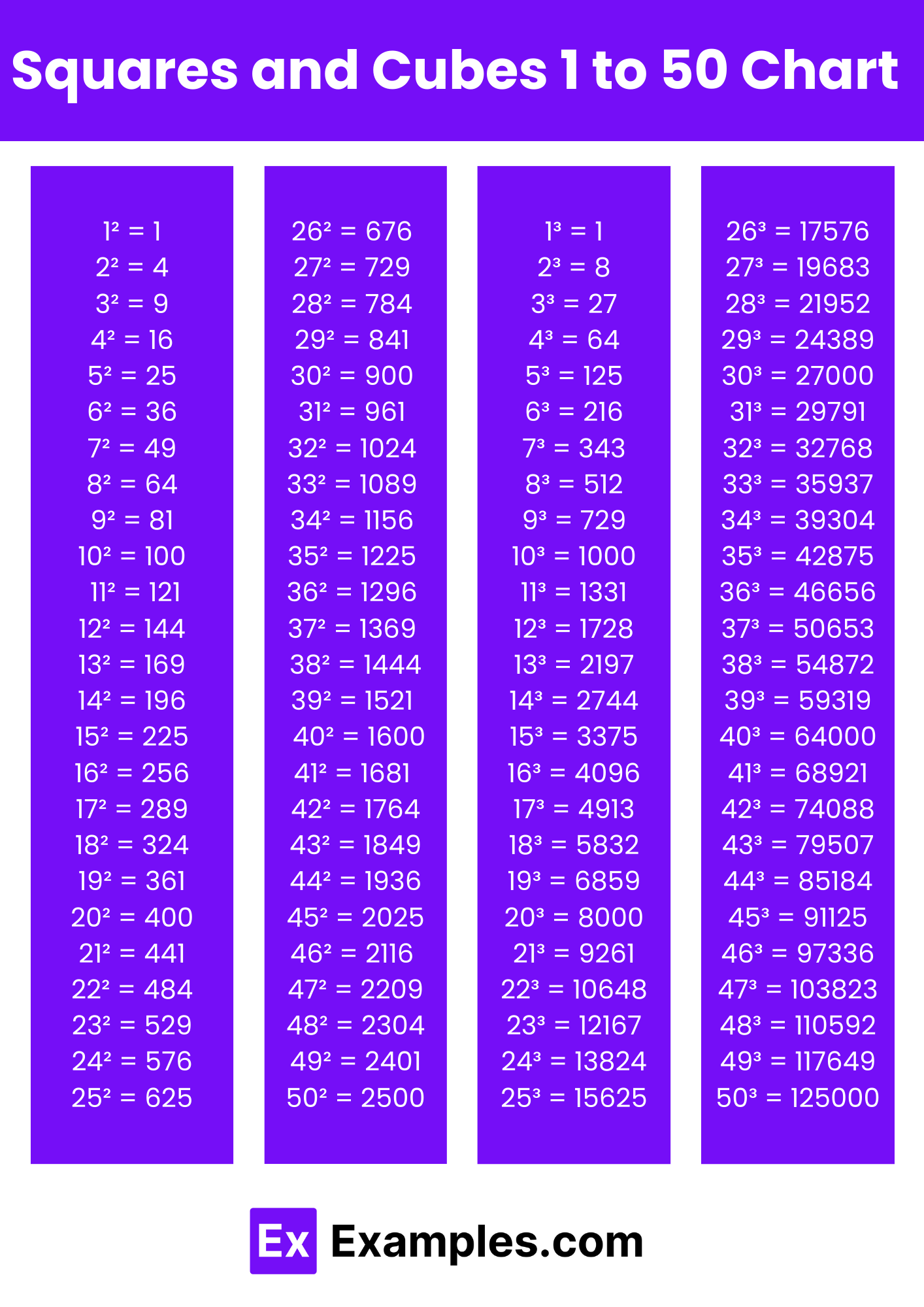What is the square of 7?
45
49
54
56


Squares and cubes form a foundational aspect of algebra and number theory, involving the multiplication of integers, rational, and irrational numbers by themselves. In mathematics, squaring a number refers to multiplying the number by itself, while cubing involves raising a number to the third power. These operations are integral to understanding concepts like square and square roots and cube roots, and they play crucial roles in statistical methodologies such as the least squares method, which is used to minimize discrepancies in data analysis. Both squares and cubes help in exploring the properties of numbers and their relationships in various mathematical contexts.
Click here to download the PDF of Squares and Cubes of 1 to 50
The square of a number is calculated by multiplying the number by itself, an operation essential in various fields like geometry, algebra, and statistics. This process forms the basis for further mathematical concepts such as square roots and quadratic equations.
The cube of a number is found by multiplying the number by itself three times. For instance, if you cube the number 3, you calculate 3×3×3 = 27. This operation is significant in mathematics as it extends into concepts of geometry (like calculating the volume of cubes), algebra, and higher-level functions involving cubic equations.

Click here to download the PDF of Squares and Cubes of 1 to 50
| Squares (n2) | Cubes (n3) | ||
| 1² = 1 | 26² = 676 | 1³ = 1 | 26³ = 17576 |
| 2² = 4 | 27² = 729 | 2³ = 8 | 27³ = 19683 |
| 3² = 9 | 28² = 784 | 3³ = 27 | 28³ = 21952 |
| 4² = 16 | 29² = 841 | 4³ = 64 | 29³ = 24389 |
| 5² = 25 | 30² = 900 | 5³ = 125 | 30³ = 27000 |
| 6² = 36 | 31² = 961 | 6³ = 216 | 31³ = 29791 |
| 7² = 49 | 32² = 1024 | 7³ = 343 | 32³ = 32768 |
| 8² = 64 | 33² = 1089 | 8³ = 512 | 33³ = 35937 |
| 9² = 81 | 34² = 1156 | 9³ = 729 | 34³ = 39304 |
| 10² = 100 | 35² = 1225 | 10³ = 1000 | 35³ = 42875 |
| 11² = 121 | 36² = 1296 | 11³ = 1331 | 36³ = 46656 |
| 12² = 144 | 37² = 1369 | 12³ = 1728 | 37³ = 50653 |
| 13² = 169 | 38² = 1444 | 13³ = 2197 | 38³ = 54872 |
| 14² = 196 | 39² = 1521 | 14³ = 2744 | 39³ = 59319 |
| 15² = 225 | 40² = 1600 | 15³ = 3375 | 40³ = 64000 |
| 16² = 256 | 41² = 1681 | 16³ = 4096 | 41³ = 68921 |
| 17² = 289 | 42² = 1764 | 17³ = 4913 | 42³ = 74088 |
| 18² = 324 | 43² = 1849 | 18³ = 5832 | 43³ = 79507 |
| 19² = 361 | 44² = 1936 | 19³ = 6859 | 44³ = 85184 |
| 20² = 400 | 45² = 2025 | 20³ = 8000 | 45³ = 91125 |
| 21² = 441 | 46² = 2116 | 21³ = 9261 | 46³ = 97336 |
| 22² = 484 | 47² = 2209 | 22³ = 10648 | 47³ = 103823 |
| 23² = 529 | 48² = 2304 | 23³ = 12167 | 48³ = 110592 |
| 24² = 576 | 49² = 2401 | 24³ = 13824 | 49³ = 117649 |
| 25² = 625 | 50² = 2500 | 25³ = 15625 | 50³ = 125000 |
| Squares of Numbers | Cubes of Numbers | ||
| 1² = 1 | 16² = 256 | 1³ = 1 | 16³ = 4096 |
| 2² = 4 | 17² = 289 | 2³ = 8 | 17³ = 4913 |
| 3² = 9 | 18² = 324 | 3³ = 27 | 18³ = 5832 |
| 4² = 16 | 19² = 361 | 4³ = 64 | 19³ = 6859 |
| 5² = 25 | 20² = 400 | 5³ = 125 | 20³ = 8000 |
| 6² = 36 | 21² = 441 | 6³ = 216 | 21³ = 9261 |
| 7² = 49 | 22² = 484 | 7³ = 343 | 22³ = 10648 |
| 8² = 64 | 23² = 529 | 8³ = 512 | 23³ = 12167 |
| 9² = 81 | 24² = 576 | 9³ = 729 | 24³ = 13824 |
| 10² = 100 | 25² = 625 | 10³ = 1000 | 25³ = 15625 |
| 11² = 121 | 26² = 676 | 11³ = 1331 | 26³ = 17576 |
| 12² = 144 | 27² = 729 | 12³ = 1728 | 27³ = 19683 |
| 13² = 169 | 28² = 784 | 13³ = 2197 | 28³ = 21952 |
| 14² = 196 | 29² = 841 | 14³ = 2744 | 29³ = 24389 |
| 15² = 225 | 30² = 900 | 15³ = 3375 | 30³ = 27000 |
The square of a number is the result of multiplying that number by itself.
Cubing a number means multiplying the number by itself three times.
Squares and cubes are essential in various mathematical fields, including algebra for solving equations, geometry for calculating area and volume, and statistics for mathematical modeling.
Memorizing a basic table of squares and cubes for numbers 1 through 10 is a helpful way to quickly calculate these values without needing to perform the multiplication each time.
Squares are used to calculate areas of squares and rectangles, while cubes help determine the volume of cubic objects, necessary in fields like architecture, engineering, and physics.
In algebra, the formulas 𝑎² and 𝑎³ represent the square and cube of a variable 𝑎, respectively. These are used in expanding expressions and solving polynomial equations.
Yes, fractions and decimals can be squared and cubed just like integers by multiplying them by themselves the required number of times.
Squaring and cubing are specific cases of exponentiation, where the exponent is 2 for squaring and 3 for cubing, denoted as 𝑎² and 𝑎³.
Squaring a negative number results in a positive number because multiplying two negatives gives a positive. Cubing a negative number results in a negative, as the odd number of negatives in the multiplication remains negative.
Yes, geometrically, squaring a number can be visualized as creating a square with sides of that length, whereas cubing a number can be seen as forming a cube with sides of the given length.
Text prompt
Add Tone
10 Examples of Public speaking
20 Examples of Gas lighting
What is the square of 7?
45
49
54
56
What is the cube of 4?
64
56
48
72
Which of the following numbers is a perfect square?
50
60
81
100
What is the cube root of 27?
2
3
4
5
Which number is both a perfect square and a perfect cube?
16
64
100
121
What is the square of 12?
144
156
169
180
What is the cube of 2?
6
8
10
12
Which of the following is not a perfect square?
49
56
64
81
Find the cube of 5.
100
125
150
175
What is the square root of 144?
10
12
14
16
Before you leave, take our quick quiz to enhance your learning!

